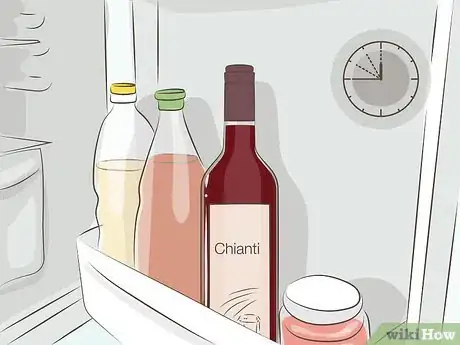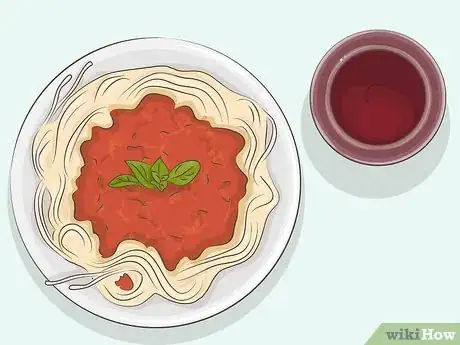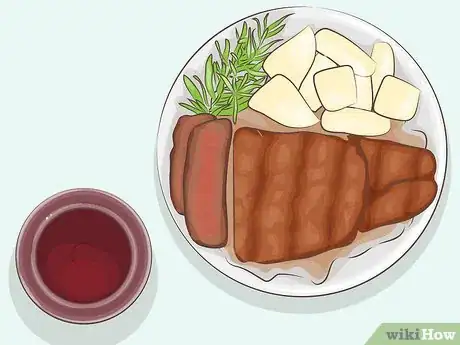This article was co-authored by Samuel Bogue and by wikiHow staff writer, Hannah Madden. Samuel Bogue is a sommelier based in San Francisco, California. He is the Wine Director of the renouned Ne Timeas Restaurant Group and a wine consultant for other top restaurants in the San Francisco Bay area. He gained his Sommelier certification in 2013, and since then has been recognized as a Zagat "30 Under 30" award winner and a Star Chefs Rising Star.
There are 10 references cited in this article, which can be found at the bottom of the page.
This article has been viewed 12,695 times.
You might have seen a bottle of Chianti hanging in a straw basket at your local liquor store. Chianti is a medium-bodied red wine that’s both fruity and spicy (and it’s easy on the wallet, too). If you’ve picked up a bottle of Chianti or you’re thinking about getting one, there are only a few things you need to know before you serve it up to your guests tonight.
Steps
Chilling and Pouring
-
1Put the bottle of Chianti in the fridge for 45-60 minutes before serving it. Chianti wine is best served chilled but not cold. Try to get it down to a temperature of 55 to 60 °F (13 to 16 °C) before you serve it.[1]
- You shouldn’t store Chianti in the fridge, though. If it’s too cold, you’ll miss out on the more subtle notes in the flavor. Keep it at room temperature until just before serving it.
- Chianti wine is usually fairly young (most bottles are less than 2 years old), so you don’t need to decant it before serving.
-
2Serve the Chianti in a red wine glass. It’s a stemmed glass with a slightly tapered rim, used most often to serve red wines. The glass will help to accentuate the Chianti and pick out the fruit and mineral notes.[2]
- If you don’t have a Chianti-specific glass, a universal red wine glass is fine, too.
Advertisement -
3Chill the empty wine glasses in the freezer for 2-3 minutes. It will keep the wine chilled longer and enhance the tasting experience. A couple of minutes (2 to 3) is perfect.[3]
- Be careful not to leave your glass in the freezer for too long! Wine glasses can shatter if they get too cold.
- This is a great trick to use if you don’t have quite enough time to chill your wine for long enough.
-
4Fill each glass about 1/3 of the way with Chianti. You don’t need a lot of Chianti wine to enjoy it. Fill up your glass about 1/3 of the way to let everyone have a glass.[4]
- A good rule of thumb is to stop pouring when the wine reaches the top of the sloped part of the wine glass.
Tasting
-
1Smell the wine to pick out the notes of cherry and incense. Hold the glass up to your nose and take a deep sniff.[5] See if you can pick out the fruity notes (cherry) and the mineral notes (incense).[6]
- You might also notice other red fruits, like blackberries or raspberries, as well as spices, like cloves.
- Try to keep your mouth open while you smell the Chianti.[7]
-
2
-
3Take a sip and hold it in your mouth for a moment before swallowing. Take a moment to appreciate the acidic flavors of the Chianti on your tongue. You might also notice an herbaceous taste, like basil or tomato leaf.[10]
- You can drink your wine normally after you’ve had a tasting sip, but it’s nice to really hold the wine in your mouth to get all the flavors when you first try it.
- As you taste the wine, try to confirm some of the flavor profiles that you noticed earlier.[11]
Food Pairings
-
1Try hearty cheese, like Pecorino or Romano, for an appetizer. Parmesan is a good choice too! The bolder the flavor of the cheese, the better it will pair with the strong acidity of Chianti.[12]
- If you don’t want to eat straight cheese, add some to your meal instead.
-
2Eat a meal with red sauce, like spaghetti or pizza, for a classic pairing. Chianti is often served with spaghetti and meatballs or Italian pizza. It’s herbaceous and acidic, so it both cuts through the red sauce and adds to it, too.[13]
- You could even try Chianti with spaghetti bolognese.
-
3Pair Chianti with steak for a robust meal. Chianti is very acidic, so it won't fall flat when compared to a hearty dish like steak. The savory red meat with the robust flavors of the wine make a great pairing for a hearty meal.[14]
- Some red wines tend to get lost when paired with red meat, but not Chianti!
-
4Enjoy a glass of Chianti with roasted lamb to balance the flavors. Lamb has a lot of flavor and tends to contain a lot of fat, which pairs perfectly with the acidity of Chianti. Lamb is also more tender than beef, so it’s a nice one to try if you aren’t feeling a steak dinner.[15]
- Lamb can be a little gamey, but the Chianti can help balance that out.
Warnings
- Try not to leave your glassware in the freezer for too long, or it could shatter.⧼thumbs_response⧽
References
- ↑ https://www.bonappetit.com/columns/the-foodist/article/red-wine-to-chill-or-not-to-chill
- ↑ https://www.winemag.com/2015/03/03/your-cheat-sheet-to-serving-wine/
- ↑ https://www.voyedgerx.com/vrx-blog/2019/1/18/chianti-wine-the-popular-italian-red-wine-you-must-taste
- ↑ https://www.youtube.com/watch?v=JjvU-HcWSAQ&feature=youtu.be&t=61
- ↑ Samuel Bogue. Sommelier & Wine Consultant. Expert Interview. 15 January 2019.
- ↑ https://www.youtube.com/watch?v=JjvU-HcWSAQ&feature=youtu.be&t=60
- ↑ Samuel Bogue. Sommelier & Wine Consultant. Expert Interview. 15 January 2019.
- ↑ Samuel Bogue. Sommelier & Wine Consultant. Expert Interview. 15 January 2019.
- ↑ https://www.youtube.com/watch?v=__edva3P-fA&feature=youtu.be&t=254
- ↑ https://www.youtube.com/watch?v=__edva3P-fA&feature=youtu.be&t=257
- ↑ Samuel Bogue. Sommelier & Wine Consultant. Expert Interview. 15 January 2019.
- ↑ https://www.winemag.com/2012/10/10/the-perfect-twist-wine-and-cheese-pairing/
- ↑ https://vinepair.com/articles/everything-you-never-knew-about-chianti/
- ↑ https://www.voyedgerx.com/vrx-blog/2019/1/18/chianti-wine-the-popular-italian-red-wine-you-must-taste
- ↑ https://vinepair.com/articles/everything-you-never-knew-about-chianti/
































































